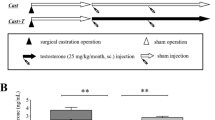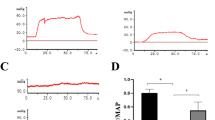Abstract
The molecular mechanism of nitric oxide synthase (NOS)-containing nerve regeneration is still unknown. It is believed that growth factors are involved in this phenomenon. We investigated the change of NOS containing nerve fibers and the mRNA expression of insulin like growth factor (IGF)-I, nerve growth factor (NGF), transforming growth factor (TGF)-α, TGF-β1, TGF-β2, TGF-β3, vascular endothelial growth factor (VEGF), endothelial NOS (eNOS) and neuronal NOS (nNOS) on the penis after cavernous nerve neurotomy in rats.
Male rats were divided into four groups: (1) sham operation (n=14); (2) unilateral neurotomy of a 5 mm segment of the cavernous nerve (n=21); (3) unilateral neurotomy with growth hormone (n=14); and (4) bilateral neurotomy (n=21). Electrostimulation of the intact cavernous nerve or pelvic ganglion were performed at one, three and six months. Nicotinamide adenine dinucleotide phosphate (NADPH) diaphorase staining and immunohistochemistry were used to identify NOS in the penis. The gene expression for growth factors, eNOS and nNOS were investigated in corporal tissue by reverse transcriptase-polymerase chain reaction (RT-PCR).
One month after neurotomy, both unilateral and bilateral neurotomy groups showed significant decreases in NOS-containing nerve fibers on the dorsal and intracavernosal nerves on the side of neurotomy. Significantly lower mRNA expression of nNOS, IGF-I and TGF-β2, higher mRNA expression of eNOS and VEGF189 were shown in these groups. At three months, the number of NOS-containing nerve fibers in the unilateral neurotomy group increased only slightly, while the GH-treated group showed a significant increase. At six months, those in the intracavernosal nerve only increased in a significant amount (P<0.0001), however mRNA expression of nNOS, IGF-I and TGF-β2 showed a significant increase as early as at three months. After bilateral neurotomy, the NOS-positive nerve fibers in the dorsal and intracavernosal nerve were significantly decreased at one month and remained so at six months; no erectile response could be elicited by pelvic ganglion stimulation. In the unilateral neurotomy group at six months, more NOS-positive neurons in the pelvic ganglia were found on the intact side than on the side of the neurotomy (P<0.003), indicating that the regeneration derived from pelvic ganglion neurons on the intact side. Furthermore, electrostimulation in the unilateral neurotomy group revealed a greater maximal intracavernosal pressure and a shorter latency period at six months than at one month P<0.014, P<0.001, respectively).
These data suggest that IGF-I and TGF-β2 may play a key role in the regeneration of nNOS-containing nerve fibers in the dorsal and intracavernosal nerves, and eNOS increases temporarily in the intracavernous involving VEGF189 after unilateral cavernous nerve injury.
This is a preview of subscription content, access via your institution
Access options
Subscribe to this journal
Receive 8 print issues and online access
$259.00 per year
only $32.38 per issue
Buy this article
- Purchase on Springer Link
- Instant access to full article PDF
Prices may be subject to local taxes which are calculated during checkout
Similar content being viewed by others
Author information
Authors and Affiliations
Rights and permissions
About this article
Cite this article
Jung, G., Kwak, J., Yoon, S. et al. IGF-I and TGF-β2 have a key role on regeneration of nitric oxide synthase (NOS)-containing nerves after cavernous neurotomy in rats. Int J Impot Res 11, 247–259 (1999). https://doi.org/10.1038/sj.ijir.3900402
Received:
Accepted:
Published:
Issue Date:
DOI: https://doi.org/10.1038/sj.ijir.3900402
Keywords
This article is cited by
-
Low serum insulin-like growth factor-1 in patients with erectile dysfunction
Basic and Clinical Andrology (2016)
-
Differentially expressed microRNAs in the corpus cavernosum from a murine model with type 2 diabetes mellitus-associated erectile dysfunction
Molecular Genetics and Genomics (2016)
-
Intracavernous administration of bone marrow mononuclear cells: a new method of treating erectile dysfunction?
Journal of Translational Medicine (2013)
-
Emerging tools for erectile dysfunction: a role for regenerative medicine
Nature Reviews Urology (2012)
-
IGF-1 levels are significantly correlated with patient-reported measures of sexual function
International Journal of Impotence Research (2011)



